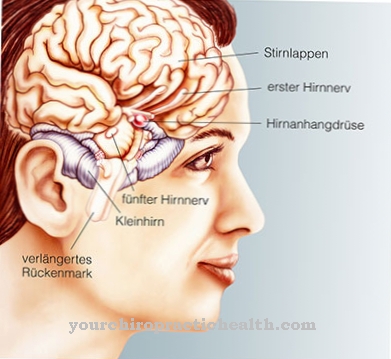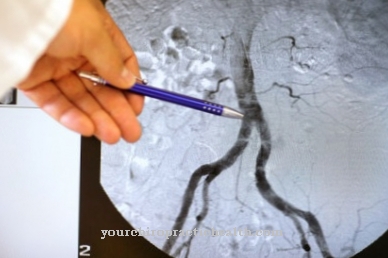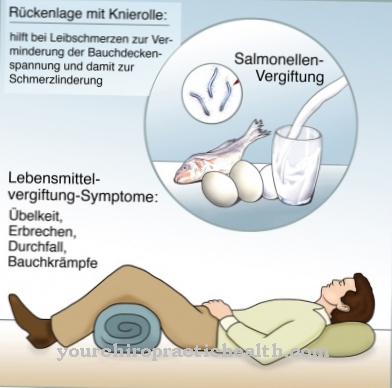When congenital and hereditary Hypodontia If one to five permanent teeth of the jaw are not created, if six teeth are not created this is called oligodontics and if all teeth are missing anodontics. Hypodontia can also be acquired and is then often due to damage and stunting of the tooth germ or environmental factors such as radiation.
What is hypodontia?

© stockdevil - stock.adobe.com
The Hypodontia is a technical term from the dental field and describes the missing attachment of one or more permanent teeth. The term oligodontics must be distinguished from the term. This is a special case of hypodontia in which more than five teeth are missing. A second special case is anodontics, in which patients suffer from non-placement of all teeth.
From one Hypodontia spuria or simulated hypodontia, in contrast to real hypodontia, is always used when the missing teeth are in place but not erupting. While real hypodontia corresponds to a congenital anomaly of the teeth, dentistry understands false hypodontia to be an acquired dentition anomaly, which is also expressed in missing teeth.
causes
Congenital hypodontias are among the most common anomalies of the dentition. Missing systems for wisdom and incisors are among the most common forms. As a rule, congenital hypodontias are hereditary and are sometimes passed on via an autosomal dominant inheritance with variable expressivity and incomplete penetrance. All genes that are involved in tooth development can carry the defect.
However, under certain circumstances, real hypodontia can also occur as a result of a developmental disorder and thus be associated with certain diseases. In addition to hemolytic anemia and Down syndrome, diseases such as Curtius or Bloch-Sulzberger syndrome can also be associated with hypodontia.
Acquired and fake hypodontia, on the other hand, are often the result of accidental damage to the teeth, which triggered premature tooth loss. Damage to the bone marrow or increased X-ray exposure may just as well be related to acquired hypodontia. More rarely, the cause is a central dislocation of milk teeth, which can damage the attached tooth germs and cause them to wither.
If radiation therapy took place before the adult dentition developed, this may also have triggered hypodontia. Apart from those mentioned, many other environmental factors are probably able to promote hypodontia before the adult dentition develops.
Symptoms, ailments & signs
If several teeth are not applied, this multiple non-application is often accompanied by additional dental symptoms. Above all, form anomalies should be mentioned in this regard. Dysplastic posterior teeth of the upper tooth ridge are just as much a part of it as the aplasia of other tooth germs, which indicates a general weakness in the formation of the tooth racks.
Under certain circumstances, a crossbite may also occur if there are no teeth in the upper tooth bar. If, on the other hand, the lower jaw is affected, the bite may sag. Tilting of the remaining teeth can indicate a general instability of the tooth ridge and occur as an accompanying symptom of every hypodontia. Which symptoms are associated with hypondontia in individual cases depends heavily on the number and location of the missing teeth.
Diagnosis & course of disease
The diagnosis of hypodontia is usually made by X-ray diagnosis. The missing teeth can usually be easily seen on the imaging. Hypodontia remains static for life, so that in the narrower sense it cannot be referred to as the course of the disease. The success of the treatment depends heavily on which and how many teeth are affected.
Untreated hypodontia often results in severe misalignments of the jaw and in this context can trigger improper strain that causes additional symptoms such as severe and chronic headaches. Since hypodontia is also an aesthetic problem, untreated patients sometimes suffer from psychological problems. Therefore, early treatment for hypodontia is particularly crucial for a positive outcome.
Complications
The hypodontia leads to considerable malformations and deformities in the area of the mouth and jaw. The patients suffer from missing teeth, so that in most cases either five or six teeth are missing. Likewise, the rest of the teeth are deformed or not in the right places. It is not uncommon for a so-called cross bite to occur.
The stability of the teeth is reduced so that they can break off and become damaged more easily. The everyday life of the person affected is extremely limited by hypodontia, as there are problems with eating. Those affected are often dependent on liquid food because they cannot chew solid food. The toothache can also lead to headache or earache.
In most cases, the malformations can be treated surgically so that there are no further restrictions and complications in everyday life. However, this treatment is only possible in adulthood. In childhood, children can suffer from teasing or bullying and develop psychological problems as a result. The life expectancy of the person affected is not restricted by hypodontia.
When should you go to the doctor?
Hypodontia must always be treated by a doctor. This disease does not self-heal and there are usually serious restrictions in the life of the person affected if the disease is not treated in time. The doctor should then be seen if the person is missing teeth.
The number and position of the missing teeth can vary greatly. In most cases, the symptoms are already noticeable in childhood. The dentist can recognize this. In some cases, the other teeth are tilted or misaligned due to hypodontia, which can lead to pain when ingesting food. The quality of life of the person affected is considerably reduced by the hypodontia.
In the case of hypodontia, a dentist or an orthodontist should be seen first and foremost. This can usually treat hypodontia relatively well. Early diagnosis and treatment have a positive effect on the course of the disease and can prevent possible complications.
Doctors & therapists in your area
Treatment & Therapy
All types of hypodontia can be treated with orthodontic, prosthetic, implantological and oral surgery measures. While the maxillofacial surgery measures are primarily intended to prevent incorrect bites, incorrect loads and evasive postures due to missing teeth, an implantation or transplant can also be carried out in the form of operations.
In addition, retained teeth may be exposed in an operation. General dental prosthesis treatments can also make sense and lead to the desired result. The planning of the treatment measures and the coordination of the individual steps can only be carried out on a case-by-case basis. The number of teeth that have not been created, as well as the condition of the teeth and the position of the entire set of teeth, influence the planning of therapy measures.
The size and position of the jaw as well as existing diseases of other types should not be ignored. When planning treatment, financial aspects must also be taken into account, which may rule out some of the available measures from the outset.
You can find your medication here
➔ Medicines against tartar and tooth discolorationprevention
While the congenital form can hardly be prevented, acquired hypodontia can be prevented under certain circumstances. The economical use of X-ray irradiation and measures to reduce the risk of dislocation in milk teeth can play a role in this context.
Aftercare
With the congenital form of the disease, there are no specific preventive and follow-up options. Acquired hypodontia can, however, be prevented by taking certain measures during aftercare. Among other things, it is helpful to use X-rays as sparingly as possible. Reducing the risk of dislocation in milk teeth can also have a positive effect on health.
Even after the treatment of the misalignment, the dentist should make regular appointments to examine the teeth closely and to follow the changes. If necessary, he takes further measures in addition to the actual treatment in order to optimize the correction. Those affected should take special care of their teeth during this time and use the care products recommended by the doctor.
Often he also gives advice on a sensible change in diet. By not consuming luxury foods and dieting, patients avoid possible bleeding. Coffee, tea, nicotine and alcohol can interfere with wound healing immediately after the treatment. Spicy foods and extremely cold or hot stimuli also have a negative effect on the healing process.
Instead, soothing herbal teas are helpful. The doctor gives the patient useful information on the permitted foods, which are particularly gentle in porridge form. With a pronounced deformity, the patients often feel psychologically affected and need supportive psychotherapy.
You can do that yourself
People who suffer from hypodontia should first have the deformity examined by a dentist. Depending on the severity of the hypodontia and the proposed treatment method, the therapy can be supported by some measures.
After an operation, the person concerned should take it easy and treat the teeth with special care products according to the doctor's instructions. Since the oral cavity is usually still very irritated, the diet has to be changed temporarily. Coffee, alcohol, tea and nicotine should be avoided in the first few days, as otherwise bleeding or wound healing may be impaired. Spicy dishes as well as overly hot and cold dishes should also be avoided. Porridge-like dishes and soothing herbal teas are recommended. The doctor in charge is best able to answer exactly which foods are allowed.
Hypodontia must definitely be treated medically. At most, treatment is not necessary for very slight misalignments. The cosmetic blemish can, however, lead to emotional complaints that have to be treated by a therapist. If pain, inflammation or other symptoms develop, a visit to the dentist or orthodontist is indicated.


.jpg)










.jpg)

.jpg)
.jpg)











.jpg)